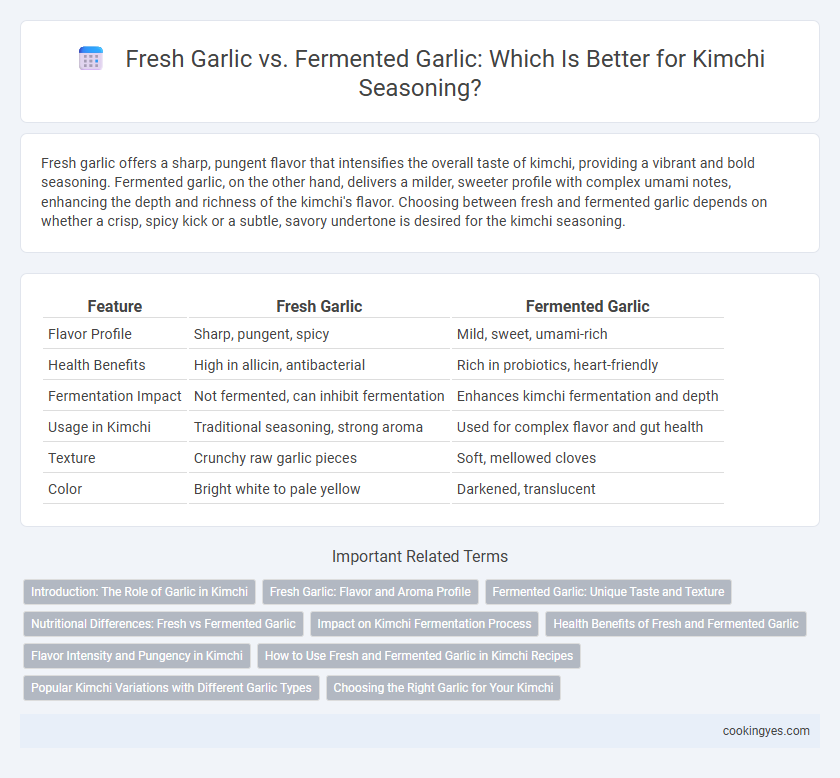Fresh garlic offers a sharp, pungent flavor that intensifies the overall taste of kimchi, providing a vibrant and bold seasoning. Fermented garlic, on the other hand, delivers a milder, sweeter profile with complex umami notes, enhancing the depth and richness of the kimchi's flavor. Choosing between fresh and fermented garlic depends on whether a crisp, spicy kick or a subtle, savory undertone is desired for the kimchi seasoning.
Table of Comparison
| Feature | Fresh Garlic | Fermented Garlic |
|---|---|---|
| Flavor Profile | Sharp, pungent, spicy | Mild, sweet, umami-rich |
| Health Benefits | High in allicin, antibacterial | Rich in probiotics, heart-friendly |
| Fermentation Impact | Not fermented, can inhibit fermentation | Enhances kimchi fermentation and depth |
| Usage in Kimchi | Traditional seasoning, strong aroma | Used for complex flavor and gut health |
| Texture | Crunchy raw garlic pieces | Soft, mellowed cloves |
| Color | Bright white to pale yellow | Darkened, translucent |
Introduction: The Role of Garlic in Kimchi
Garlic plays a crucial role in kimchi seasoning by enhancing its pungent aroma and depth of flavor. Fresh garlic imparts a sharp, spicy bite that energizes the fermentation process, while fermented garlic offers a milder, sweeter profile contributing to complex umami notes. The choice between fresh and fermented garlic significantly influences kimchi's taste, texture, and aroma development during fermentation.
Fresh Garlic: Flavor and Aroma Profile
Fresh garlic in kimchi seasoning delivers a sharp, pungent flavor and a vibrant, zesty aroma that enhances the overall freshness of the dish. Its natural enzymes contribute to a crisp texture and a slightly spicy bite that intensifies during fermentation. The bright, unmistakable scent of fresh garlic helps balance the tangy and spicy notes typical in authentic kimchi recipes.
Fermented Garlic: Unique Taste and Texture
Fermented garlic in kimchi seasoning offers a distinctive umami-rich flavor profile that enhances depth and complexity, setting it apart from fresh garlic's sharpness. Its softened texture integrates smoothly into the kimchi paste, promoting uniform fermentation and a balanced taste. The fermentation process also reduces pungency while amplifying beneficial probiotics, contributing to kimchi's health benefits.
Nutritional Differences: Fresh vs Fermented Garlic
Fresh garlic in kimchi seasoning offers higher allicin content, which supports immune health and has stronger antimicrobial properties compared to fermented garlic. Fermented garlic contains increased levels of antioxidants and bioactive compounds like S-allyl cysteine, enhancing cardiovascular benefits and reducing oxidative stress. The fermentation process also reduces the pungency of garlic while boosting its probiotic effects, contributing to improved digestion and gut health in kimchi.
Impact on Kimchi Fermentation Process
Fresh garlic introduces a sharp, pungent flavor and contains active enzymes that accelerate the initial fermentation stages of kimchi, promoting faster lactic acid bacteria growth. Fermented garlic, by contrast, offers a milder, sweeter taste due to the breakdown of sulfur compounds and fosters a slower, more controlled fermentation process, enhancing depth and complexity in kimchi's flavor profile. The choice between fresh and fermented garlic significantly influences kimchi's acidity development, texture, and overall microbial balance during fermentation.
Health Benefits of Fresh and Fermented Garlic
Fresh garlic in kimchi seasoning delivers high levels of allicin, a sulfur compound with potent antibacterial and antioxidant properties that support immune health and reduce inflammation. Fermented garlic enhances its probiotic content and bioavailability of nutrients like S-allylcysteine, contributing to improved digestion and cardiovascular benefits. Both forms enrich kimchi's health profile, but fermentation amplifies gut-friendly microbes and sustained antioxidant effects.
Flavor Intensity and Pungency in Kimchi
Fresh garlic delivers a sharp, intense pungency that enhances the boldness of kimchi's flavor profile, providing a vibrant and zesty kick. Fermented garlic, by contrast, offers a milder, sweeter, and more complex taste due to the enzymatic breakdown during fermentation, contributing subtle umami depth and reducing harshness in the kimchi seasoning. The choice between fresh and fermented garlic directly impacts the balance between pungency and flavor complexity, shaping the overall sensory experience of kimchi.
How to Use Fresh and Fermented Garlic in Kimchi Recipes
Fresh garlic delivers a sharp, pungent flavor essential for a vibrant kimchi base, best used minced or grated directly into the seasoning paste to provide immediate heat and aroma. Fermented garlic offers a milder, sweeter taste, developing complexity over time, and is often incorporated in smaller amounts to enhance umami while balancing the overall flavor profile. Adjust the ratio of fresh to fermented garlic depending on the desired intensity and depth, ensuring a harmonious blend that complements the cabbage and chili flakes perfectly.
Popular Kimchi Variations with Different Garlic Types
Fresh garlic offers a sharp, pungent flavor that enhances the crispness of traditional baechu kimchi, while fermented garlic provides a milder, sweeter taste ideal for mild kkakdugi. Popular kimchi variations such as oi sobagi often incorporate fresh garlic to maintain a bright, zesty profile, whereas spicy napa cabbage kimchi sometimes uses fermented garlic for depth and complexity. The choice between fresh and fermented garlic significantly influences the umami and aroma, tailoring kimchi to regional and personal taste preferences.
Choosing the Right Garlic for Your Kimchi
Choosing the right garlic for kimchi seasoning significantly impacts the flavor and fermentation process. Fresh garlic provides a sharp, pungent taste that intensifies during fermentation, while fermented garlic contributes a milder, sweeter, and more complex aroma, enhancing the overall umami profile. For a traditional kimchi with a robust garlic punch, fresh garlic is ideal, whereas fermented garlic suits kimchi recipes aiming for a subtler, deeper flavor complexity.
Fresh Garlic vs Fermented Garlic for Kimchi Seasoning Infographic

 cookingyes.com
cookingyes.com